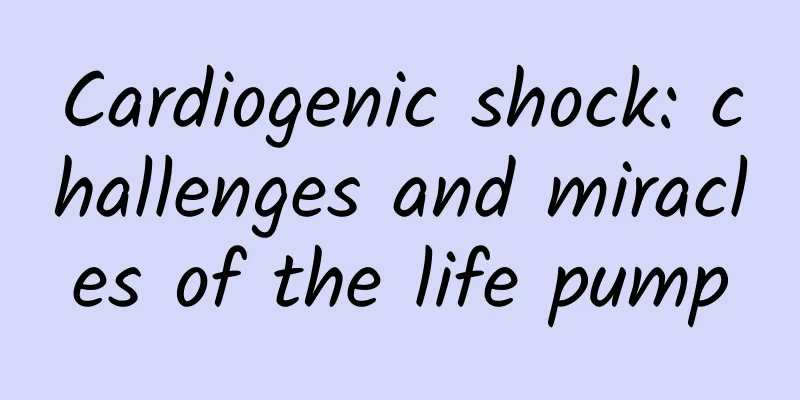Cardiogenic shock: challenges and miracles of the life pump

|
Imagine that the human heart is like a tireless pump that continuously delivers blood to every corner of the body, providing nutrients and oxygen to every cell in the body. However, when this pump fails and the amount of blood pumped is seriously insufficient, the body will fall into a crisis, which is cardiogenic shock. Today, let us walk into this mysterious and dangerous world together, explore the mystery of cardiogenic shock, and the miracle of life behind it. 1. The mystery of cardiogenic shock Cardiogenic shock is a serious medical condition that occurs when the heart suddenly loses function, causing the heart to be unable to supply enough blood to the body. This condition can be caused by heart disease such as myocardial infarction, severe arrhythmia, myocarditis, etc. When the heart's output is not enough to meet the body's needs, blood pressure drops sharply, and the body's organs and tissues cannot get enough blood and oxygen, causing a series of serious symptoms. 2. Symptoms and signs: the body’s distress signals The symptoms of cardiogenic shock are usually very obvious and severe. Patients may experience extreme weakness, dizziness, cold sweats, and clammy skin. In addition, their pulse may become weak and rapid, their blood pressure may drop significantly, and they may even become confused or comatose. These symptoms are the body's distress signal to us, telling us that the heart can no longer meet the body's blood needs. 3. Emergency treatment: race against time Cardiogenic shock is a life-threatening condition that requires immediate emergency treatment. On the way to the hospital, the patient should lie flat with the head slightly elevated to reduce the pressure on the blood supply to the brain. At the same time, the patient's emotions should be kept stable to avoid excessive tension and panic. In the hospital, doctors will develop treatment plans based on the patient's specific conditions. These usually include measures such as replenishing blood volume, using vasoactive drugs to increase blood pressure, and stabilizing heart rate. In addition, for some patients with severe cardiogenic shock, advanced treatments such as mechanical ventilation, cardiac assist devices, and even heart transplants may be required. 4. Prevention and rehabilitation: protecting heart health Although cardiogenic shock is critical, as long as we do a good job of prevention and rehabilitation, we can greatly reduce the risk of its occurrence. First of all, we must maintain good living habits, quit smoking and limit alcohol, eat a reasonable diet, exercise appropriately, and maintain psychological balance. These seemingly simple measures are actually crucial to heart health. Secondly, for patients who already have heart disease, regular check-ups and standardized treatment are the key to preventing cardiogenic shock. Regular electrocardiograms, echocardiograms and other examinations can detect abnormal changes in the heart in a timely manner, so that appropriate treatment measures can be taken. At the same time, following the doctor's advice, taking medication on time, and controlling the progression of the disease are also important means of preventing cardiogenic shock. During the recovery phase, patients need to actively cooperate with the doctor's treatment plan to gradually restore heart function. At the same time, it is also very important to maintain a good attitude and living habits. Through a reasonable diet, moderate exercise and regular check-ups, the body can gradually return to its best condition. 5. Cardiogenic shock: challenges and miracles of the life pump Cardiogenic shock is a race against time and a huge challenge to the pump of life. However, it is this challenge that makes us cherish the preciousness and fragility of life even more. With the continuous progress of medicine, we have more means to deal with the crisis of cardiogenic shock. From emergency treatment to prevention and rehabilitation, every link is full of miracles and hope of life. Let us work together to protect the health of the heart and keep the pump of life full of vitality and hope. In the face of the challenge of cardiogenic shock, let us bravely meet the challenge and create the miracle of life with wisdom and courage. |
<<: Marfan Syndrome: The flexible string that unlocks the mystery of life
>>: How to recover after giving birth?
Recommend
My period came one day and suddenly disappeared. What happened?
Menstruation is another name for female menstruat...
What is the difference between first-level Douban and red oil Douban? Which one is better?
We all know that there are many kinds of condimen...
A small method for blood sugar monitoring - continuous glucose monitoring system
Blood glucose monitoring is the key to diabetes m...
Why does my period come one week early every time?
Is it normal for the menstrual period to come a w...
Can I eat pineapple during breastfeeding?
During breastfeeding, eating some fruits appropri...
Want to have a baby after vasectomy
Some female friends want to have children after h...
I just found out I'm pregnant after 60 days of amenorrhea
Nowadays, many young women like to play, and they...
What to eat for amenorrhea
Everyone knows about menstruation, but what is am...
Repeated tearing of the vulva at the same location
If your private parts repeatedly crack, you must ...
Four good ways for women to have thick breasts
Beautiful waves can add points to your figure. Do...
Why is it itchy around the nipple?
The resistance next to our human nipple is genera...
What to do if an ovarian cyst is five centimeters
Ovarian cyst is a common gynecological disease am...
How do women exercise their chest muscles?
Women's breasts are mainly composed of water ...
Professor Zhi Xiuyi: 2022 New Year's Greetings from the Science Popularization Committee of the Chinese Anti-Cancer Association
Your browser does not support the video tag As th...
Does it mean I am not pregnant if I have my period?
Generally speaking, once a woman becomes pregnant...









